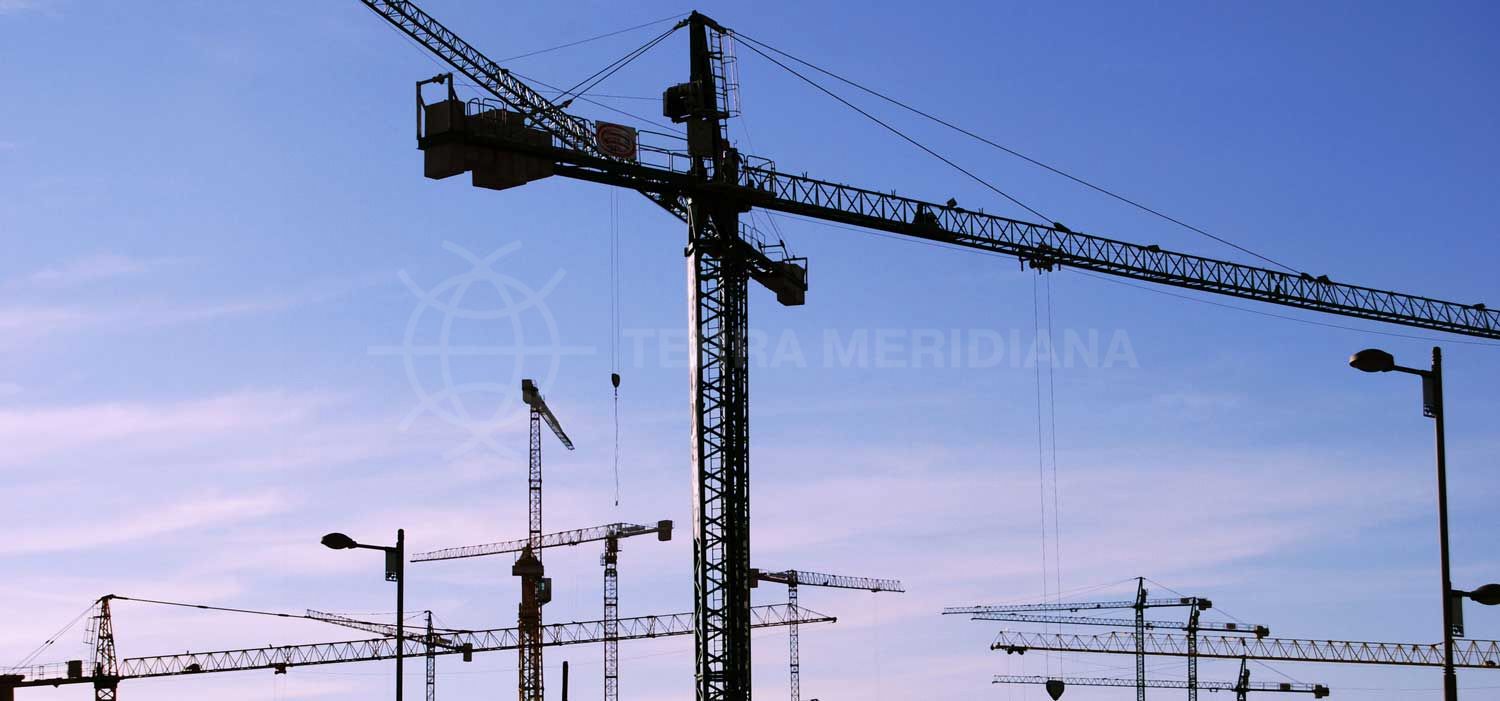Opinion
Lack of Housing Construction is Behind The Spanish Housing Crisis
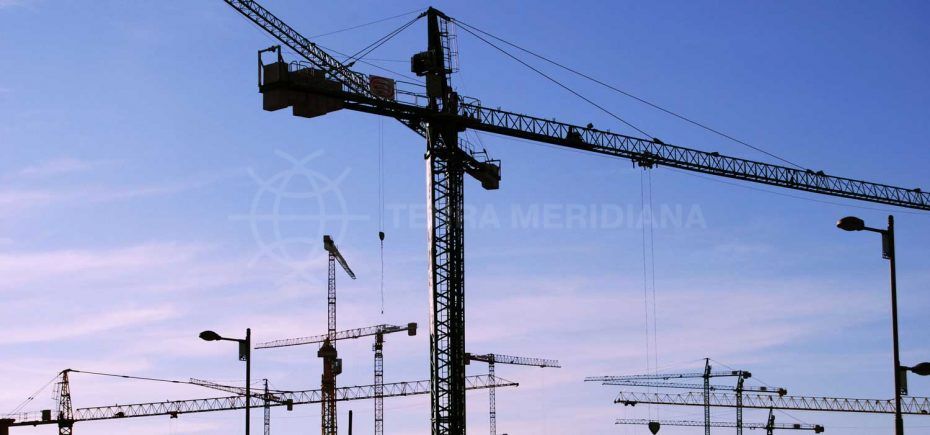
During the spring/summer high season, there was a lot of controversy, including big protests, against over-tourism and the crisis in affordable housing. This was typically connected to the perceived over-saturation of Airbnb and vacation rental properties in many cities. We have addressed some of the details of the tourism-related aspects of the housing crisis and responses to it elsewhere.
There are now some journalists and research papers that have turned to citing immigration as one of the main reasons for the lack of housing and for corresponding high sale and rental prices: ¨Immigration is obviously one of the most important drivers of rising house prices in Spain¨ it is claimed. Often this argument is cited in response to campaigns for controls on Airbnbs. The problem is not tourist rentals, the argument goes, it is demand from immigrants seeking housing and the corresponding population growth is responsible for a rise in house sale and rental prices. The problem is the data they use to justify this argument happens to correspond to the post covid housing boom in Spain, and using 2 years of any data (let alone data that deviates from the norm) to make any claim is frankly rather spurious. In fact, in the US there are research papers that suggest the rise in the phenomenon of remote working is responsible for house price increases in the years following the pandemic although to apply this to Spain may be a bit of a stretch.
Historically there are both periods where house price increases do appear to ally with immigration increases and periods where they do not. In the 1970s, although the population was growing in Spain, housing prices remained stable. In 1986, after joining the EU, prices in Spain started to spike. However, prices rose considerably at least four years before population started to grow as a result of immigration. There is obviously a link between immigration (demand) and housing and housing prices but it is not always the case that prices increase, in fact in some research it is suggested that prices go down as a result of displacement, native people moving out of immigrant areas. A lot depends it appears on the elasticity of housing demand and housing supply. To suggest a simple causal link bewteen immigration and house price increases is to deny the complexity of the issue, why do house prices rise?
One of the most obvious reasons for house price increases apart from the availability of supply and quantity of demand is the availability and quality of credit. The easy availability of credit during the last boom was one of the main drivers of the market and its collapse one of the main drivers for the ensuing recession. The recovery of the mortgage market in the last 10 years has underpinned market growth and corresponding house price increases. It would seem obvious that an increase in demand in a climate where credit is available would see an increase in house prices but what about supply? If the supply of housing is elastic then it should absorb the demand and house prices remain stable. However, in Spain what appears to be happening is the housing supply is considerably inelastic, supply is constrained, there is simply not enough housing to go round.
Demand – The current housing market in Spain is healthy
It is certainly true that when we look at home sales overall in Spain, the market looks basically healthy. As I wrote in July, the real estate market went through some intense gyrations as a result of Covid but that moment has passed.
We have returned to more sustainable growth in sales and prices. According to Trading Economics, for instance, beginning in 2016 a more or less stable equilibrium was achieved setting price increases at around 6% per year. We seem to be returning to that.
Six percent has often been higher than the broader rate of inflation but the 2007-2015 collapse was so profound that ground was being made up. Basically, Spanish housing came out of the crisis under-valued. The following chart shows both the collapse and recovery in terms of annual price changes by percentage.
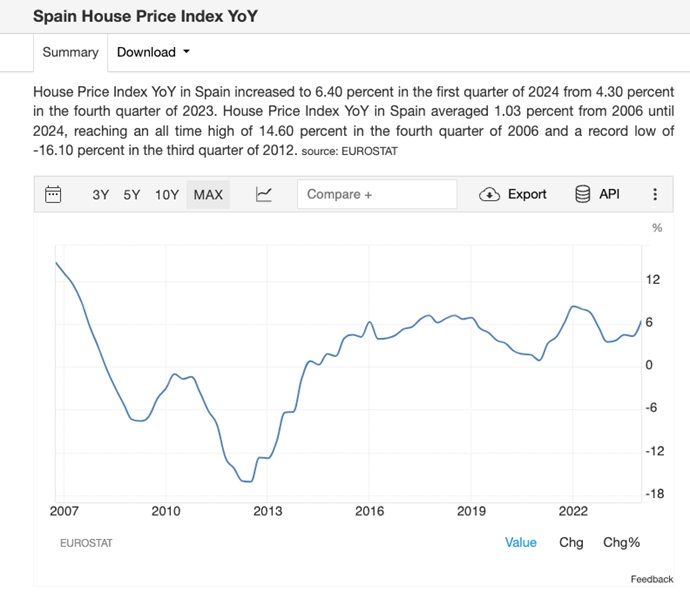
We see a similar pattern when it comes to sales of houses overall. On the website epdata.es the charts show a pattern of post-crisis boom, followed by easing growth. The Covid pandemic threw that to the wind but by 2024 we have returned to a smooth line. The chart below is created from statistics gathered by the National Institute of Statistics (INE).
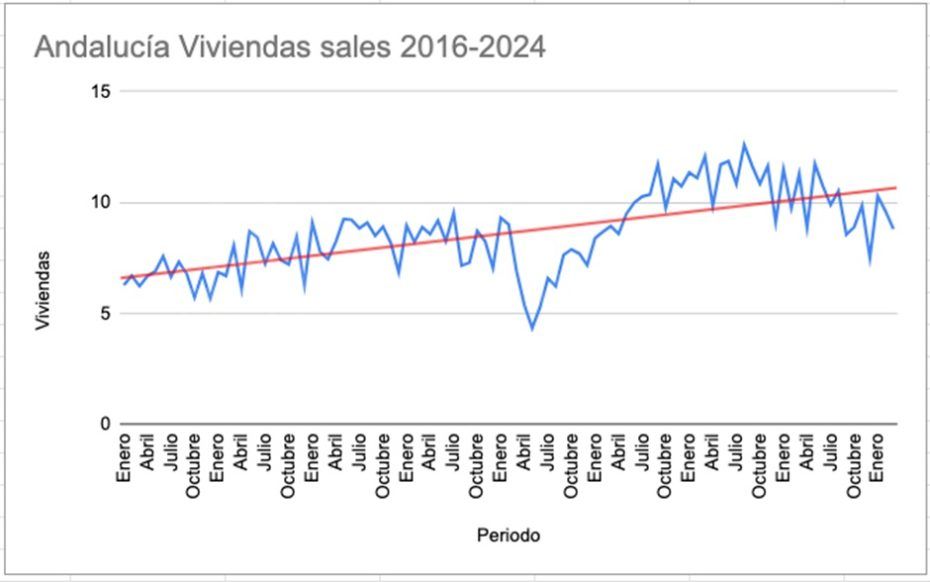
This is the good news, and it should give us heart that Spain currently has good market conditions without excess froth. The more challenging news is that the market is unbalanced between new and used home sales, as well as the number of homes needed based on household formation in Spain.
Supply – The market is unhealthy – New households are being created quicker than new homes
Back at the beginning of 2023, Caixa Bank released a study looking at the number of new households being formed and compared it to the number of new homes being built. What they found was that while 420,000 new households were created between 2020 and 2022, the number of new homes constructed was around 300,000. That’s a shortfall of 40,000 homes per year.
As you can see from the following chart, new houses bottomed in 2013, along with new household formation (represented by the grey bars). As household formation recovered, post-2018, new house construction did not. It remains basically flat.
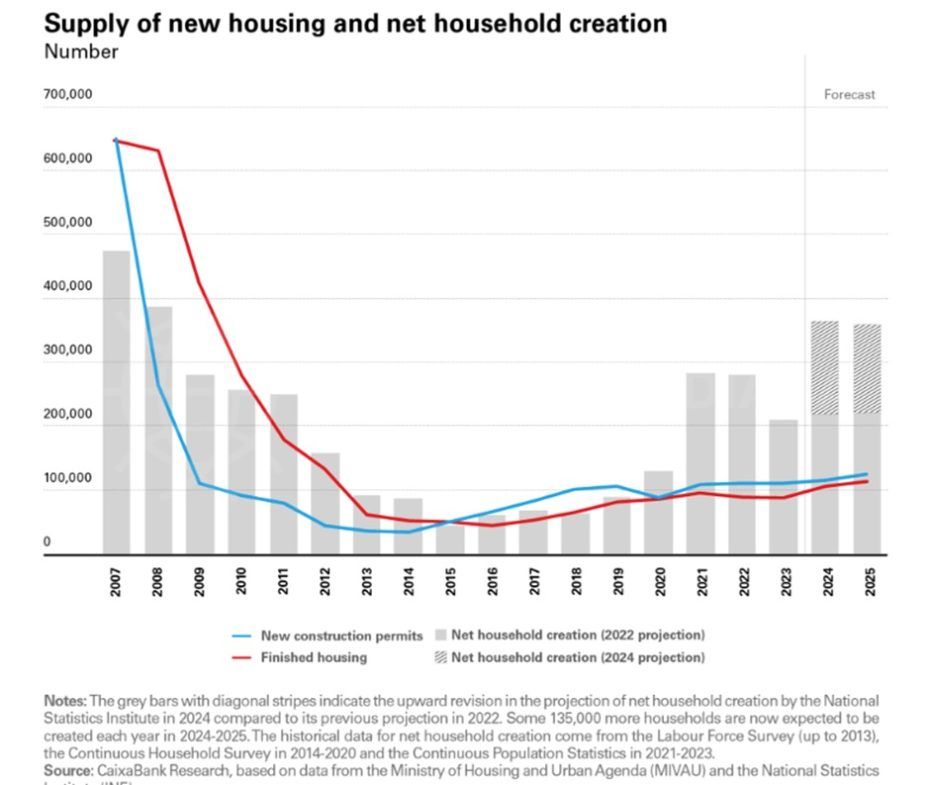
What that means is that even if every single one of the 340,000 estimated vacation apartments across the country were converted to long term rental that would only provide a short term solution to the problem.
Vacation rentals are now a key pillar of Spain’s tourist economy, which accounts for 12-14% of the country’s GDP. Eliminating that many vacation apartments would devastate the tourism economy and lead to mass unemployment. According to the government, some 2.75 million Spaniards work in the tourism sector. In other words, it’s both undesirable and insufficient to solve the problem.
Well, what about reducing the number of new households that are formed each year. Since 1976 there has been a steady decline in birth rates in Spain, with only a brief upsurge during the heady boom years from 1999-2007. And in 2017 the number of deaths surpassed the number of births for the first time, with the gap growing since then.
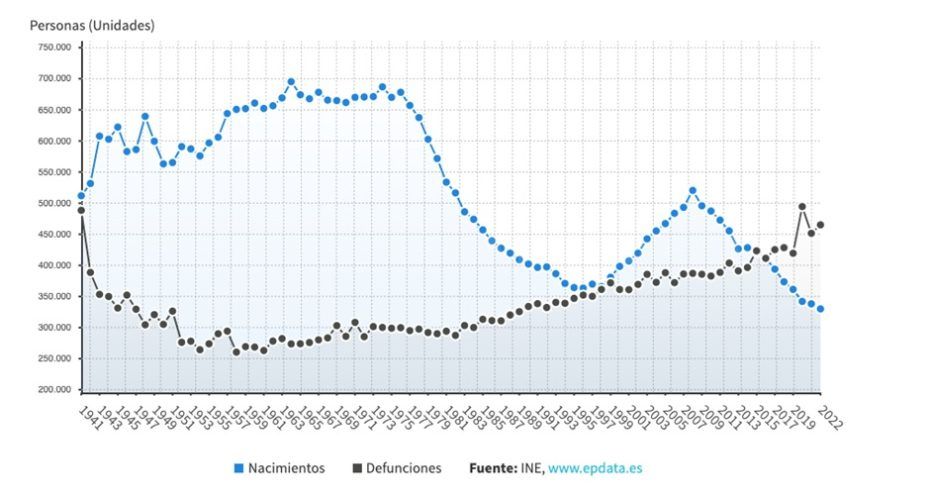
Left on its own, the Spanish population would decline, and the housing crisis would be solved. In addition, something like 150k to 200k Spaniards emigrate each year, which also reduces the number of homes needed. Of course, this ratio of births to deaths creates other problems, such as how to fund the public pension and healthcare systems as less people are of working age and more people are retired. Productivity increases can only solve so much of this imbalance.
The number of new households, which the Caixa study estimates will be 217,000 per year for at least the next five years, is coming almost exclusively from immigration. Spain’s current population is just over 48 million. The immigrant population in Spain as of 2024 is 8.2 million or 18% of the total population. As a study in 2023 noted from the Migration Policy Institute:
Accounting for nearly 16 percent of its population, Spain has one of Europe’s highest shares of foreign-born residents. Far exceeding the EU average (12 percent) and the proportion of immigrants living in other Southern European countries such as Italy (10 percent), Spain’s share is in the ballpark of those of Germany (18 percent) or the Netherlands (14 percent), which have received sizable immigration flows for much longer periods of time.
But what is the actual contribution immigrants make to the Spanish economy?
The Elcano Royal Institute, a thinktank headed by the Spanish king, notes that Spain’s “native population” is aging out in a way the raw statistics don’t fully demonstrate. The Royal Institute, unlike the Wikipedia article linked above, counts anyone born outside the country as an immigrant. That includes naturalized citizens. They make the following point:
The foreign-born population in Spain now accounts for 18% of total population, but accounts for a far higher proportion of the population of active age: for every 100 native-born Spaniards at the age of greatest labour market participation (25 to 49 years), there are 38 immigrants.
In other words, almost half of the working age population in Spain are not native-born Spaniards. As with the example of banning vacation apartment rentals, it would be economic madness to stop the arrival of immigrants. Immigrants bring important skills that develop the Spanish economy, and their work and taxes build, staff and fund Spain’s social services. Their consumption also helps fuel Spain’s growth.
Until recently more Spaniards left the country seeking work than immigrants arrived. In the 1970s, hundreds of thousands emigrated each year. There was a government ministry purely dedicated just to coordinating Spanish emigration abroad.
Even as recently as during the housing crisis, from 2009-2015, more people left Spain than arrived. This was an important source of economic survival for Spaniards and their role in Europe benefited Europeans as a whole. Now that Spain has a thriving economy – and one that needs workers – it would be economic suicide to close the doors.
The Cure: More Houses
There are problems with “over-tourism” and the question of livability in heavily tourist areas. Spain also now has a lot of immigrants. But to blame tourism and immigration for a rise in house prices and a lack of affordable housing, is misguided and simplistic.
Everyone including the Bank of Spain agrees the solution to the Spanish housing crisis is simple, to build more houses. In the current moment, there’s a lack of new houses to meet demand although paradoxically there are still nearly 4m empty homes in Spain. The lack of new housing can be seen in statistics for housing construction. Going back to 1970 there had been a steady if modest increase in the number of housing construction. There were enough new houses to meet the increase in population.

Housing construction then accelerated as the housing boom took off in the late 90s. People bought houses as investment vehicles. Prices rose even as the supply of houses increased because there was a speculative bubble.
But then look at what happened after the housing bubble burst; a total collapse in new housing construction. And not only has housing construction not recovered to even the levels of the 1970s, they collapsed further, to effectively zero, in 2018.
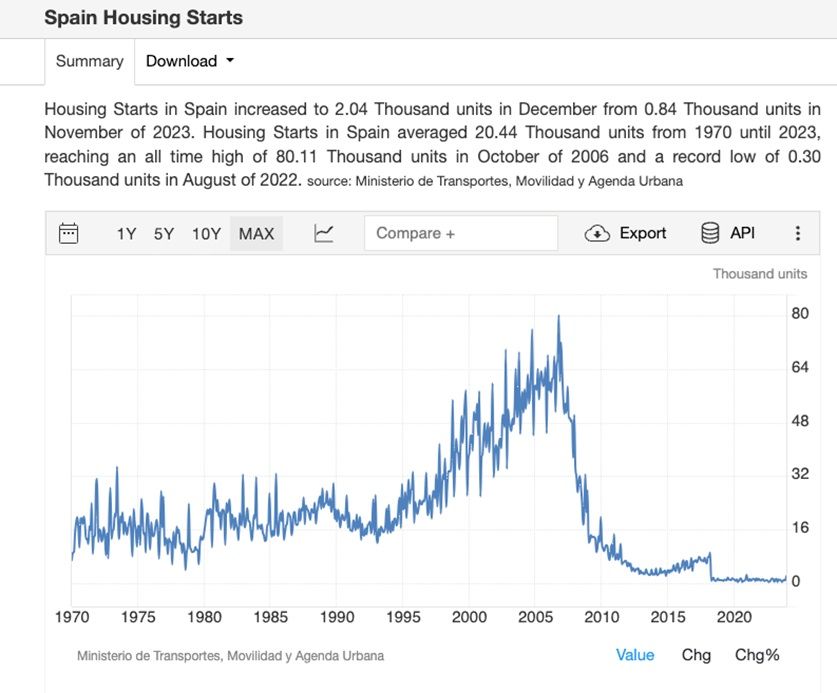
We see the same thing when we compare home sales. After 2013, Spain’s housing market begins to rise out of the post-bubble slump as shown in the table near the top of this article. There is a steady rise from that year until the Covid pandemic knocked everything sideways, before returning to normal.
However, when we break that down into new home sales and used home sales we see a similar pattern of imbalance. New home sales (green) collapse in 2015 and remain low until today. The growth in sales post-2015 is almost exclusively in second-hand homes.
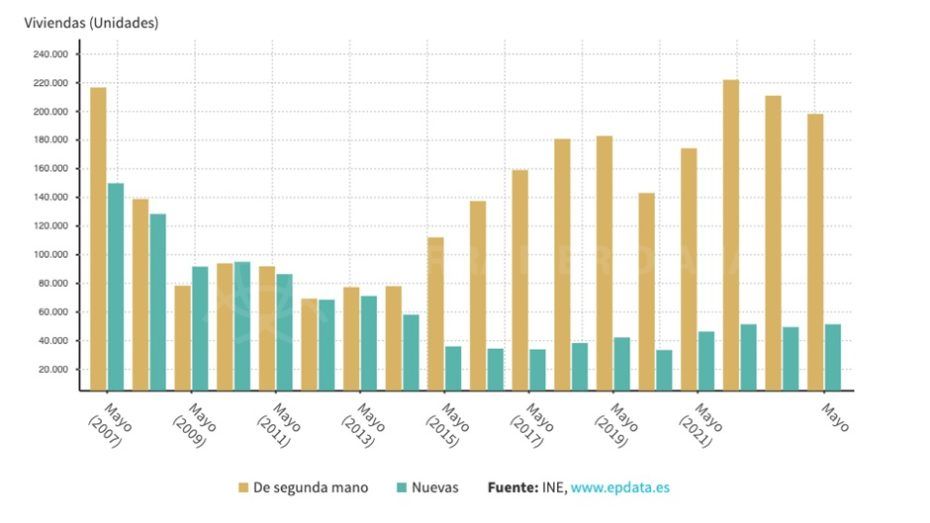
It’s important to mention this collapse in new homes is not because the construction industry as a whole has collapsed. Statistics show that since 2014 employment has consistently risen in the construction sector. As well, the statistics for “construction output” show a fluctuating but overall stable chart since 2014. The collapse is primarily in new home construction.
How did we arrive at this situation?
There are a lot of factors that have led to this situation. In the immediate wake of the bursting of the housing bubble, as the Caixa Bank study notes, there was a massive oversupply of 500,000 homes. Many projects were simply abandoned. Other houses were purchased as investments and then suffered foreclosure or had to eventually be sold off. Until that slack in the system was eliminated, there was little point to building at scale.
In addition, in the wake of Covid there continues to be significant inflation in the commodities required for construction, making it uneconomical:
“…in the period Q1 2020 – Q2 2023* the increase in the price of bituminous materials was 47%, copper 56%, ceramic materials 51%, iron and steel materials 46%, cement 42%, aluminium 40% and energy 42%.”
Developers face a further challenge. During the financial crisis many banks had to deal with the expenses and hassles of bankrupt developers and construction companies that couldn’t cover their loans. As a result, banks now impose much tougher capital requirements before releasing money to developers such as deposits for at least 50% of the development. Beyond this, there are a whole series of bureaucratic hurdles that remain in place. The Junta de Andalucia, amongst others, is attempting to deal with many of those with major overhauls to the regional and local planning processes. Hopefully, that will help to eliminate the major roadblocks, such as Marbella’s 15-year lack of an urban plan.
Finally, because of post-Covid inflation, we have had to endure two years of ever rising interest rates. These are now the highest that they’ve been since 2001. Rates are projected to ease over the next year. That will certainly help encourage people to take out mortgages but, more importantly, it will make it easier to access the capital needed for building projects.
Government intervention will also be needed to spur a reboot of the sector. The planning changes will create more certainty and agility in Andalusia and that will help. But to attract builders back to housing will require incentives and possibly direct investment by the government.
I’ve argued this elsewhere citing what is a shocking statistic – that Spain’s stock of affordable housing at 2.5% is barely 20% of the EU average and almost the lowest in the OECD.
Freezing Airbnbs isn’t going to solve that problem. Trying to link immigration to the housing crisis isn’t going to do it. Pretending that the problem will solve itself won’t do it either. With more than 200,000 new households forming every single year, the problem will deepen into a serious, difficult to solve crisis if no action is taken. The time to act is before a crisis while the sector is healthy overall.
By Adam Neale | Opinion | October 19th, 2024
